Practical Sailor tested a field of 10 tubs of paste waxes for ease of application, gloss, texture, finish, and price. Most of the products did a fairly good job of producing initial shine. The two waxes with the most glossy fiberglass test patch were not the easiest to apply nor were they the least expensive. The boat wax test included marine paste waxes and car waxes-some with carnauba-from Meguiars, Turtle Wax, 3M, Collinite, Kit, Mothers, Nu-Finish, and Star brite.
****
Thanks to an overwhelming response from readers to our request for recommended wax and polish products for comparison, Practical Sailor is now knee-deep into an update on the subject. We last presented findings of a long-term wax test in November 2004, and that report, “Wax Test Results,” is now posted online under “Tools and Techniques” at www.practical-sailor.com.
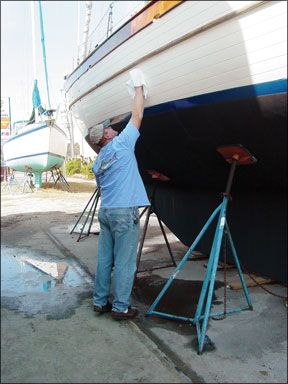
You need only dip a toe into this topic to realize that there are almost as many recipes for a glossy hull as there are sailors whod rather do anything than wax their hull. As long as marketeers keep alive our hopes for a glossy finish that will last forever, there will be people who will plunk down hard-earned money for the latest and greatest gelcoat elixir.
We generally define gloss as being the surface ability to reflect light. Gloss, along with ease of application and the ability to repel dirt and water, are the features that Practical Sailor focused on for this report (see “How We Tested,” page 32).
To contain the subject, we limited the field to paste waxes with high solids that come in a can or tub. These products are meant to be applied after the usual compounding and buffing steps. Among waxes, pastes generally provided the longest-lasting protection in comparisons by Practical Sailor. Upcoming tests will look at bottled waxes, which are quickly becoming more popular than once-common pastes. (Although the term “waxes” is a misnomer in this age of polymer coatings, we use the term loosely to describe this class of products.)
For those with hulls in good condition who are hoping to skip the compounding step, we looked at mildly abrasive two-step cleaner-waxes in March 2007, with Star brite Heavy Duty Cleaner Wax rated best. And for those interested in long-lasting acrylic finishes like Poliglow, we presented the first article in an ongoing test in September 2008. Both of these approaches have their drawbacks and advantages compared to the traditional buff-and-wax routine.
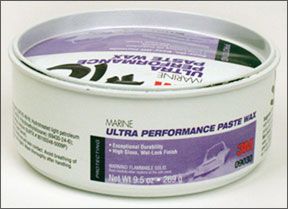
“Waxes” do more than add shine. Gelcoat is minutely porous. As it oxidizes, it gets even more porous, breaking down the glossy finish, becoming dull and chalky. It also allows penetration and build-up of dirt, smudge, and marine scum, giving it an aged look in a short time.
A wax or polish delays this process by sealing the pores and protecting against the weathering process. For a more in-depth discussion on the chemistry of gelcoat and the process of decay, see “Plastics Versus Weather: The Nature of a Losing Battle,” in our “Tools and Techniques Section,” at www.practical-sailor.com. At-large Editor Nick Nicholsons step-by-step process for restoring a weathered hull to its former glory, “Offshore Log: Gelcoat Maintenance,” can be found online in the same section.
Before we dig into the results of our paste comparison, a word about car polishes and waxes is in order. Boat gelcoat is different from the hard “clear-coat” finish on todays cars. Most ordinary car waxes do not have the same blend of ingredients to penetrate the gelcoat pores, remove oxidation, and provide a good marine sealant. However, if you have a well-polished hull, some car waxes will serve as a good final layer of protection.
What We Tested
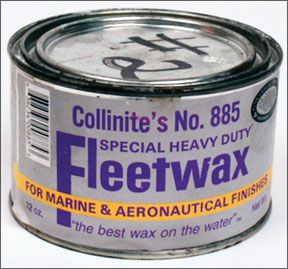
Practical Sailor
acquired 10 tubs of paste products from eight manufacturers that were advertised or recommended as boat and car waxes or polish. We looked for traditional cans of paste waxes, and products promoted as a final step in surface finishing/sealing.
Several claimed to have carnauba wax. This hard wax is extracted from leaves of the carnauba palm, grown in northeast Brazil, and has been used for many years in all kinds of products, from dental floss to lipstick. Its high demand makes it expensive.
For years, it was been mixed with beeswax and other solvents to soften it for application. Most true waxes melt above 130 degrees, but carnauba melts around 180 degrees and produces a very hard wax coating. Since all waxes have a melting point in the sun and are easily dissolved by salts, cleaning agents, and others solvents, many manufacturers now are adding synthetic polymers to bind it, soften it, and give it longevity. The percentage of carnauba in paste waxes is going down, and the perception of “paste wax” is changing. It used to be that paste wax was a hard, yellow substance that came in a metal can that required a screwdriver to open. It went on hard, dried to a white powder, and took some work to buff out. But it did produce a great shine.
Today, many manufacturers have abandoned the stiff metal can for a thin plastic container, pre-softened the wax to the point of squishy or simply gone to a liquid formula. As a consequence, most new paste waxes are blended with polymer sealants, silicones, and resins to make a soft, easy-to-apply goop. It is easier to wipe off and also produces both a glossy shine and hard protection.
Our test field of 10 supposedly “paste” waxes is certainly not all-inclusive. We favored those that did well in previous Practical Sailortests, those recently recommended, and a couple of promising new ones. We left out many that were rated Poor to Fair in previous tests for glossiness or longevity. Since this test was launched, some new products have been released, and these will be included in an update.
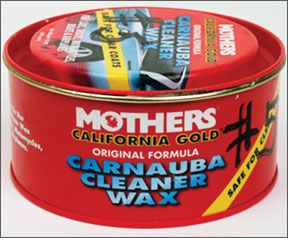
3M Marine Ultra Performance Paste Wax
Marine Ultra Performance Paste Wax by 3M (No. 09030) comes in the old-style can that must be pried open. It is a hard paste wax that includes carnauba wax, naphtha, and “trade secret siloxanes” (floropolymers, acrylic, silicon, and some UV protection). The can is very specific in advising how “very harmful” the chemicals can be to the skin or if inhaled. The coating is extremely slippery, water repellent, and resists decay by salt and sun. It is one of the harder waxes, but goes on easily and produces an excellent shine.
Bottom line: This wax fared well in this comparison and held up well in our last long-term test. Commonly used in boatyards and by some professional detailers, it is a one of our Recommended products.
Collinite No. 885
Collinite No. 885 Fleetwax for Marine and Aeronautical Finishes is a hard, heavy-duty, non-abrasive paste wax. It was developed to seal and shield against acid rain, salt spray, UV rays, bugs, and dirt. It continues to be a favorite among professional detailers, although many prefer the softer, bottled version. Being a heavier wax, the paste takes some rubbing to get on and some serious buffing to get off, but it does machine buff to a brilliant shine.
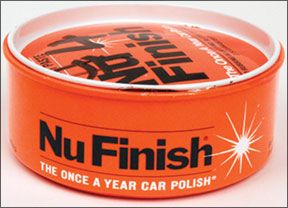
Bottom line: The top-rated paste in our last test, this product yielded the deepest gloss, but it is the most difficult to apply, is expensive (use sparingly), and the can is prone to rusting if stored on a boat. It is best suited for machine application, but is worth the effort. We recommend it for machine application.
Kit Carnauba Car Wax
Kit Carnauba Car Wax, called a “car detailer,” is a pre-softened natural yellow Carnauba paste wax that claims to have micro-polishing agents for extra shine and durability. It proved too runny and messy compared to the others we tested, and the shine was only fair.
Bottom Line: This product is messy to apply and provided only a moderate gloss.
Meguiars Flagship Premium
Meguiars Flagship Premium Marine Paste wax comes in a twist-top can that includes an applicator sponge. It will remove light oxidation and does provide UV protection. A medium-hard, creamy paste, it was one of the easiest to apply and produced a gloss comparable to that of the Collinite, with less effort.
Bottom line:
Quick to apply, and yielding a glossy finish, this is one of testers two favorites for hand application.
Mothers California Gold Cleaner Wax
Mothers California Gold Carnauba Cleaner Wax touts a hard carnauba wax blend, and it is indeed one of the harder textured pastes tested. It has an interesting musky scent (perhaps a marketing attempt at sex appeal), and despite its hardness, it went on easily and produced a deep gloss.
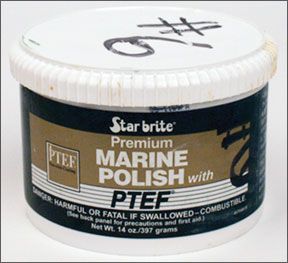
Bottom line: This was one of the favorite hard pastes in this test. We recommend it, despite (or possibly because of) the intoxicating perfume.
Nu-Finish Soft Paste
Nu-Finish Soft Paste is a white, semi-liquid polish that contains no wax, and goes on easily with no rubbing and no buffing. It claims to have five times the protection of regular waxes, can be applied in the sun, and will last a full year under normal conditions. The creamy, somewhat gelatinous substance goes on easily and produced an average to good shine.
Bottom line: Although some Practical Sailor readers and Consumer Reports have rated this wax well, our testers are so far unimpressed. Long-term results may change that outlook.
Star Brite Premium
Star brite Premium Marine Polish is a very soft goo in a flexible plastic container. Containing PTEF (the chemical equivalent of Teflon) and UV inhibitors, it is touted as a marine cleaner/sealant, with strong cleaning solvents-not a wax. Testers found the paste to be lumpy. (Star brite says this is not normal, suggesting old stock.) Easy to apply, it produced an unremarkable finish.
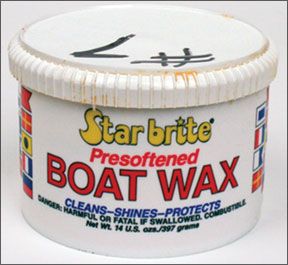
Bottom line: Initial results did not justify the higher price, in our opinion.
Star Brite Presoftened Boat Wax
Star brite Pre-softened Boat Wax is also a very soft, semi-liquid in a rustproof plastic container, and lives up to its name as pre-softened. It easily squishes right out of the can. It was also lumpy (again suggesting old stock) and required some mixing to get a uniform consistency. On the test boat, the finish did not bead water as well as others did.
Bottom line: Testers had expected to get better results from this moderately expensive product.
Turtle wax Super Hard Shell Wax
Turtle Wax Super Hard Shell Wax is a very soft green goo that can easily ooze out of the can, even with the flimsy top in place. It comes with an applicator sponge, and is gooey to apply but easy to remove. It was the most economically priced but yielded only a fair gloss.
Bottom line: Unless youre waxing nostalgic about waxing the family station wagon, there are better products in this price range.
Turtle Wax F-21
Turtle Wax F-21 Car Polish is a medium soft polish in a can with a screw-on top and sponge applicator. It claims to have a new nano-tech formula that goes on easier, requires no buffing, and lasts longer. The F-21 does not fit in the final wax category because it is designed as a combo cleaner/polish/protectant. However, it was the easiest to apply, and the urethane polymer formula produced a hard shiny finish. Turtle Wax also offers its T-411, a traditional carnauba/polymer blend, that is better suited as a finishing wax and protectant. Also, Turtle Wax is promoting its new “ICE” products, including T-465 “Ice Paste.”
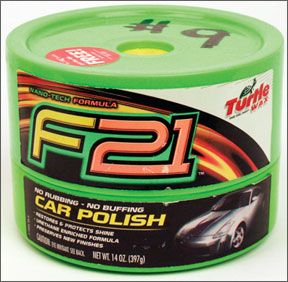
Bottom line: This product is targeted primarily to auto buffs, but for an owner of a small boat looking for a quick finish with good gloss, this is our Budget Buy.
Conclusions
Practical Sailor
tested 10 products that are fairly representative of the various types of waxes on the market today. Most did a fairly good job of producing an initial shine. Two with hard wax in the traditional metal cans, Collinite No. 885 and 3M Marine Ultra Performance, had the best glossy shine. However, they were not the easiest to apply and were definitely the most expensive. Another hard wax in a metal can that went on easier, had a good shine, and a moderate price, was Mothers California Gold Carnauba Wax.
Of the slightly softer-textured paste waxes that had the best overall combination of ease of application, mid-range price, and a nice shine, Meguiars Flagship Ultra Performance was our favorite, with Nu-Finish coming in second.
The Budget Buy nod goes to Turtle Wax F-21. For the price, it is easy to apply and buff out, and produces a better-than-average shine.
In some cases, the difference in gloss, water beading, and reflection was hard to determine. The flashlight test and shine on the white hatch cover did not always match gloss obtained on our test boat, thus the different ratings on our chart.
The chart also shows a wide range of prices. The car waxes from auto-parts stores are the most economical. As expected, those that are truly a “third-step” marine hard wax, without cleaners, were the most expensive. They also produced exceptional gloss. Based on past results, we suspect they will also last the longest.
The real test for shine will come in the next few months as we examine our test boat and white fiberglass hatch cover that have been out in the Florida weather. Look for a follow-up article.
We also will be going forward with a look at bottled and spray waxes in future installments.


































Great aritcle! The best boat wax has a lot to offer. It’s not only capable of giving my boat the glossy shine but also protection from the sun’s UV rays and wear and tear.